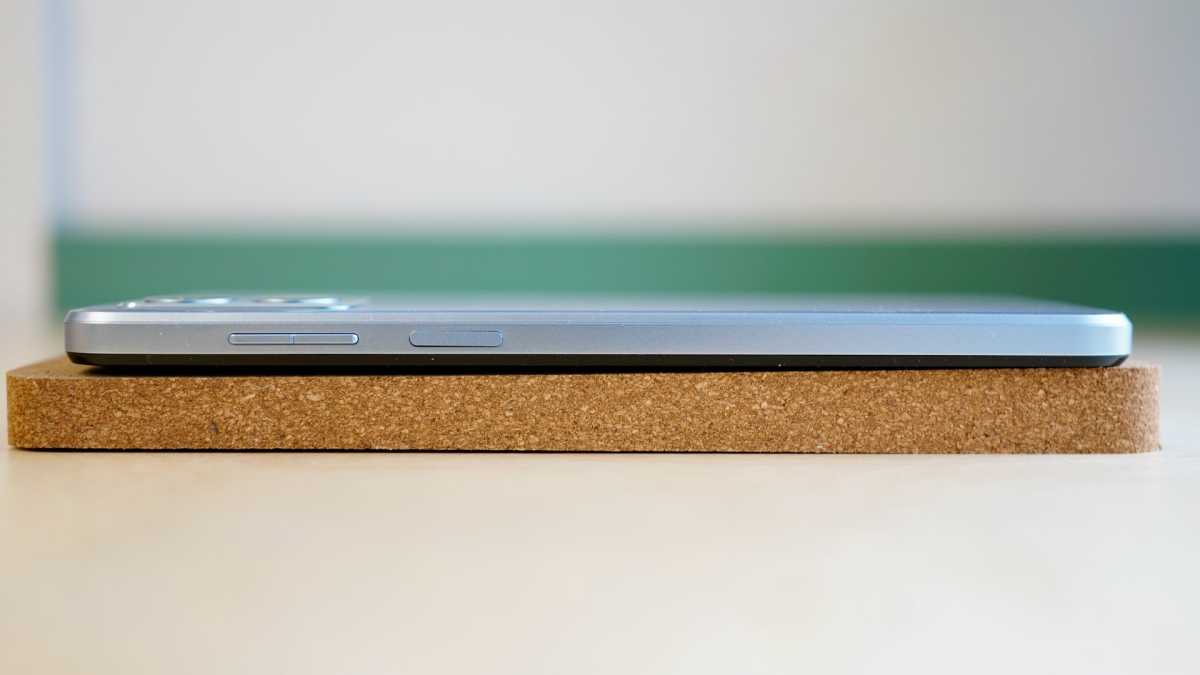Motorola Moto G53 5G review
Expert’s Rating
Pros
- Decent, slim design
- Typically excellent Motorola software
- Solid battery life
- 5G support
Cons
- Display only 720p
- Poor performance
- Sub-optimal charger bundled in
Our Verdict
The Moto G53 5G is a good sub-£200 phone, but it fails to stand out in an increasingly crowded space – with Motorola itself providing much of the filler. It’s appealing enough to look at and use, particularly with Motorola’s clean software, but the lack of a decent 1080p display is a major drawback and performance is somewhat mediocre.
Price When Reviewed
Unavailable in the US
Motorola has pretty much blitzed us with tidy but samey £200-ish phones in recent times and you can see why. This sort of phone has brought the Lenovo-owned brand considerable success, even prompting it to vacate the flagship category for a time.
The latest intense Moto bombardment contains four (yes, four!) cheap phones, but today we’re focusing on the second-from-top Moto G53 model (below the Moto G73 5G). It’s a familiar package, offering a 120Hz display, a 50Mp camera, a sober all-plastic design, 5G connectivity, and of course the brand’s fat-free software. Is that enough to warrant a recommendation, though?
Design & Build
- Tidy, flat plastic body
- USB-C, 3.5mm headphones jack, stereo speakers
- Fingerprint sensor in side-mounted power button
You can tell Motorola is a seasoned vet at this whole cheap phone thing. Building an affordable handset is generally an exercise in not drawing attention to the less-than-premium materials that are inevitably used, and Motorola does that as well as anyone.
The rear cover, meanwhile, has a frosted finish that looks nice and classy
Picking up the Moto G53 doesn’t elicit any strong emotions, and that’s a good thing. My Arctic Silver model is one of three muted tones (the others being Ink Blue and Pale Pink) that all come across as safe and business-like.
The materials, while plastic, feel solid in the hand, with little sign of creak or flex. The rear cover, meanwhile, has a frosted finish that looks nice and classy, even as it attracts fingerprints – yes, even on this lighter tone.
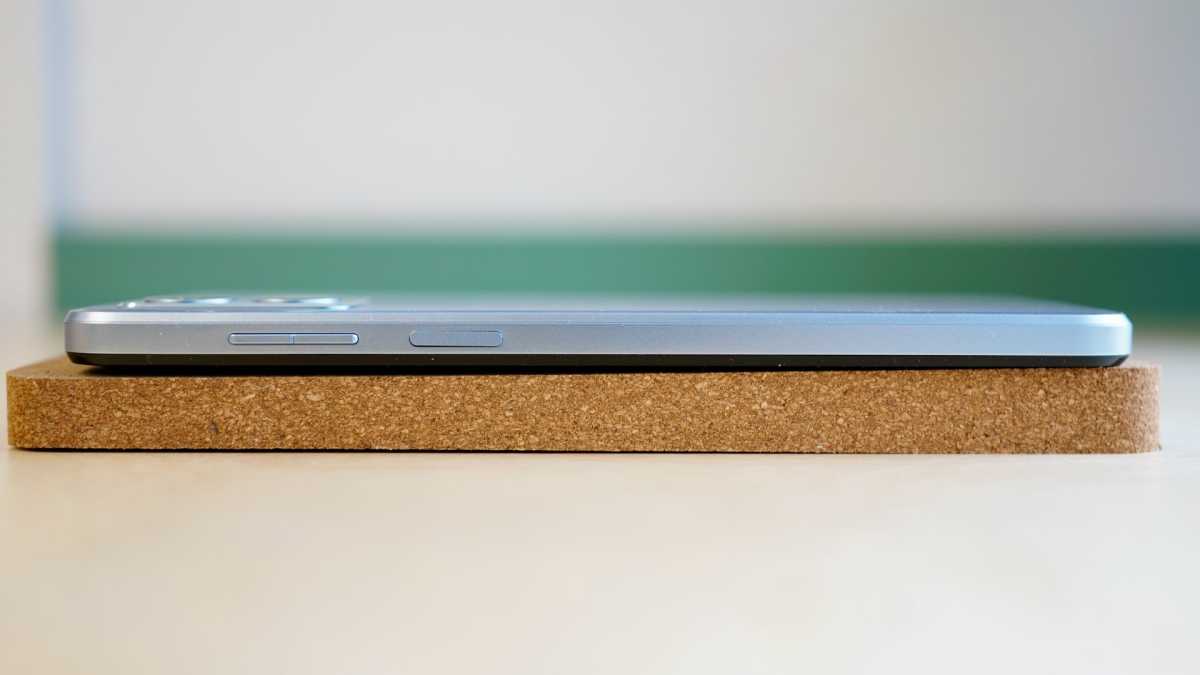
Jon Mundy / Foundry
The Moto G53’s flatter design, with no hint of curvature to the rear panel, is closer to the Moto G22 than the Moto G62. It’s relatively thin as a result, with an 8.2mm-thick chassis. Otherwise, it measures a pretty typical 162.7 x 74.7mm and weighs a just-so 183g.
The brand’s typically “water-repellent” finish means that it’ll stand up to the odd splash, but you wouldn’t want to drop it in a puddle or take it out during a torrential downpour.
You get a reliable fingerprint sensor built into the power button on the right-hand edge, though it’s not particularly quick about its unlocking business. That likely comes down to the slow processor at the core of the phone, however. You get the usual 3.5mm headphone jack and USB-C ports on the bottom edge.
Screen & Speakers
- 6.5in HD+ LCD
- 120Hz refresh rate
- Not particularly colour-accurate
Last year I praised the Moto G62 for not picking up Motorola’s nasty habit for including sub-Full HD displays on its G-series phones. Sadly, that habit is back on display with the Moto G53. Which, don’t forget, has an RRP that’s only £10 cheaper than the G62’s launch price.
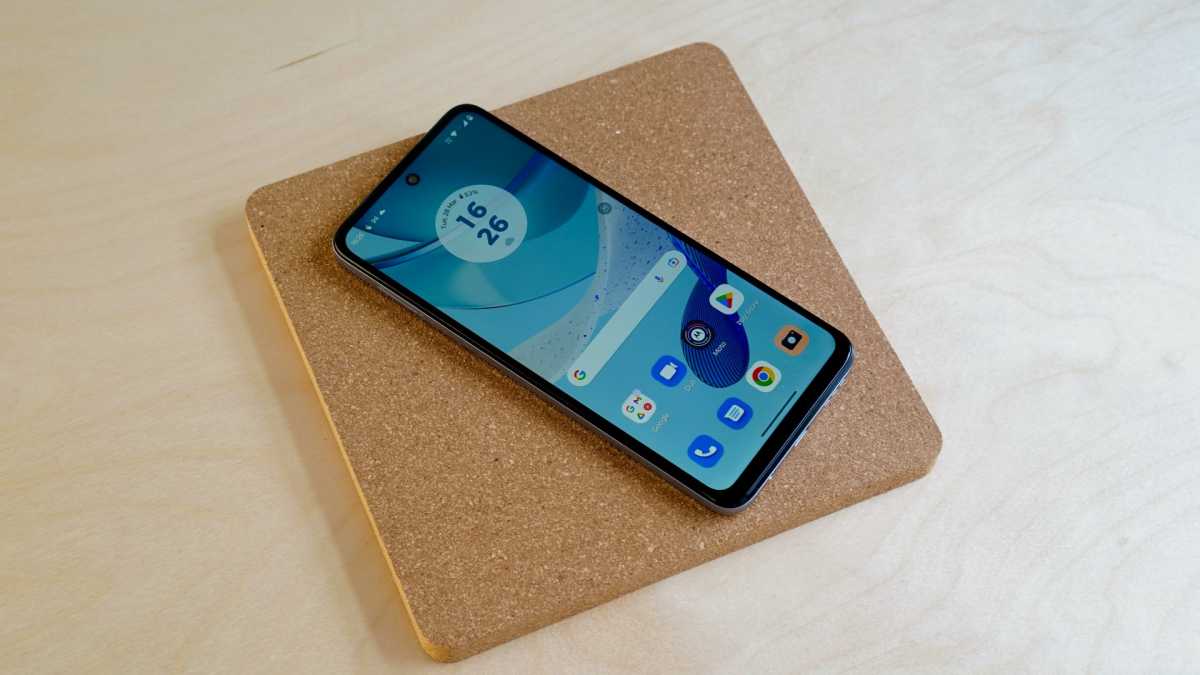
Jon Mundy / Foundry
I won’t go into too much detail on the whole objection to 720p displays again, other than to say that Full HD or 1080p should really be the default resolution for all but the absolute cheapest (£100 or less) handsets. Videos, photos, and web content just look way better at this resolution, especially on the super-sized displays that we’ve come to accept as normal.
On that front, the Moto G53’s screen measures in at 6.5in. Not huge, then, but certainly not small enough to warrant such a shortfall in pixels.
The provision of a 120Hz refresh rate is all well and good, but the phone’s limited processor and RAM provision don’t exactly let you enjoy the full extent of that spec. I’d have preferred that Motorola had taken the Poco M5 route and scaled back to 90Hz, perhaps redirecting those resources towards an FHD+ resolution.
It’s also an IPS LCD, so you don’t get vibrant colours to make up for the lower resolution, while blacks are more like dark greys. In terms of colour accuracy, the Natural colour mode is a better bet (in sRGB terms at least) than the ramped up default Saturated mode. Even then, a gamut coverage of 89.9%, a gamut volume of 90.1%, and a Delta E score of 1.57 really isn’t particularly strong, trailing behind the Poco M5 and the Moto G62.
I recorded a peak brightness of 454 nits with auto-brightness turned off, which is reasonable.
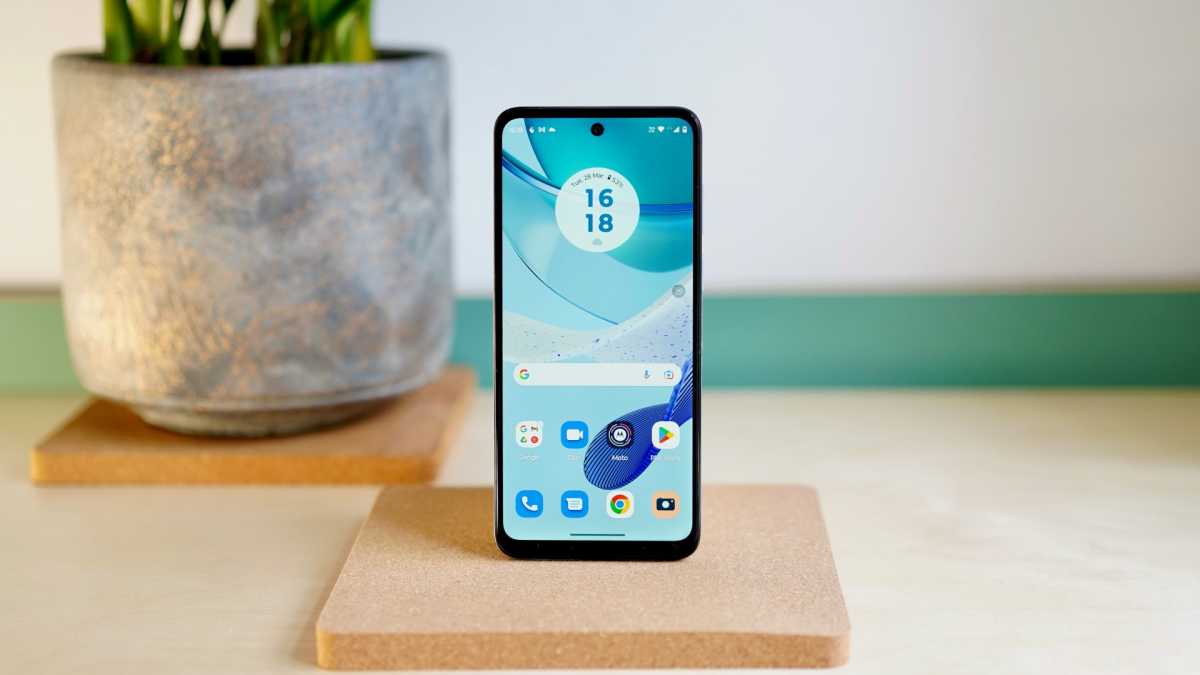
Jon Mundy / Foundry
In a nutshell, then, the Moto G53 display isn’t very sharp or colour-accurate, and it only gets moderately bright. It’s perfectly usable, but you can do better for the money.
Stereo speakers are always welcome on a sub-£200 phone, so it’s good to see them here – especially with Dolby Atmos support. There’s a predictable lack of low-end oomph to them, but the clarity is pretty decent for the money.
Specs & Performance
- Snapdragon 480+ 5G processor
- 4GB of RAM
- 5G connectivity
The Moto G53 is powered by the Snapdragon 480+ 5G, which is a known quantity – not least because it’s the same chip that powered last year’s Moto G62. You get the same 4GB of RAM as that phone, too.
This processor doesn’t make for a particularly snappy experience whilst navigating around between home screens and menus
As I’ve already alluded to, this processor doesn’t make for a particularly snappy experience whilst navigating around between home screens and menus. It’s not unusable by any means, but you’ll experience frequent micro-stutters when doing fairly ordinary tasks.
An average Geekebench 5 multi-core score of 1600 actually drops a little short of its predecessor, and well short of the Poco M5 with its speedy MediaTek Helio G99 chip. The Moto G53 hits back in the GPU benchmark stakes, but that can be accounted for by the fact that the Poco is having to drive a superior 1080p display.
One improvement over the likes of the Moto G62 and the Poco M5 is the provision of 128GB of storage as standard. You can expand that by up to 1TB, too, thanks to the provision of a microSD card slot.
Motorola has gone all in on 5G connectivity again, though this continues to be a ‘high-end’ feature I’d happily ditch in favour of nailing some of the basics. I’d take an FHD+ display, a faster processor, or an ultra-wide camera over very-occasionally-faster mobile connectivity.
Cameras
- 50Mp wide camera
- No ultra-wide
- Pointless 2Mp macro sensor
It looks like the Moto G53 comes with a dual camera set-up, but there’s actually only one proper 50Mp wide camera. The other lens is accounted for by a 2Mp macro camera which, as always, isn’t really much use at all.
Seriously, manufacturers, if you’re going to include a camera that literally focuses on the finer details of life, at least give it sufficient pixels to sell the whole concept. To be fair, you can get nice and close to your subject (about 4cm with a fixed focus), but the level of sharpness is poor.

Jon Mundy / Foundry
The main 50Mp camera is seemingly the same as the Moto G62 and Moto G22 before it, and as such is capable of capturing some pleasing shots in good lighting, with colours that pop without looking too false. Auto HDR generally kicks in reliably and compensates well for extremes of light and shade, though I did pick out some telltale signs of overexposure on a fairly bright early-Spring day.
As you might expect, low light shots are where things fall apart. The combination of a very small 1/2.76” image sensor with a lack of OIS (optical image stabilisation) and a humble ISP (image signal processing) results in very noisy night shots. It perhaps says something that Night Vision is buried away in the More sub-menu, but then low light shots without this mode active are noticeably worse.
There is no ultra-wide camera here, which is a shame, but not quite the disaster some might think it to be. Yes, it would have been nice to have the option of framing landscape shots in a more zoomed out way. Conversely, most affordable and even mid-range smartphone ultra-wide cameras suck. If it hadn’t been for that pointless macro camera, I might even have praised Motorola for its fat-trimming approach.
Portrait shots tend to leave a blurry halo around the subject, and you might find that you lose the edge of an ear or some other fairly crucial detail. It doesn’t look bad, as such, just not quite right.
The Moto G53’s 8Mp front camera does a passable job in good enough lighting, though detail isn’t particularly strong and skin tones are a little smudgey. It’ll do for those social media posts, which is what it’ll generally be used for.
Battery Life & Charging
- 5000mAh battery
- Two-day battery life
- Weedy 10W charging
Motorola has equipped its budget phone with a healthy 5000mAh battery. Together with that low-res display, fuss-free software, and a tried and tested processor, it would have been a shock if the Moto G53 was good for anything less than a day and a half of regular usage.
You’ll often be able to get to the end of a second day of usage
As it is, you’ll often be able to get to the end of a second day of usage if you’re a lighter user and don’t hit the media too hard. A day of moderate usage tended to drop me down just past the halfway mark into the forties.
Running the PCMark Work 3.0 battery test yielded a score of 10 hours and 24 minutes, which isn’t sensational, but isn’t unusual for a phone of this price. Part of this is because I ran the test with the screen set to 120Hz – leave it in Auto and it brings back a much better score of 12 hours and 54 minutes.

Jon Mundy / Foundry
The main criticism I have with the Moto G53 when it comes to battery matters is that Motorola has only bundled it with a measly 10W charger. Using this puny brick, 15 minutes of charging from empty got me to just 10%, while half an hour yielded a mere 21%. It took more than 2h 30m to get to 100%.
Interestingly, the phone can seemingly support a little faster. I plugged in a Samsung 65W charger, and the telltale ‘TurboPower’ symbol appeared on the lockscreen. 15 minutes then took the phone to 13%, while 30 minutes took it to 26%. Still not speedy, but better.
Software
- Android 13
- Motorola’s usual useful gesture embellishments
- Slow hardware weighs it down somewhat
As always with Motorola, software is one of the Moto G53’s strongest elements. The brand’s thoughtful handling of Android is a delight, and I wish more manufacturers would follow suit.
This is a largely stock Android 13 experience as you would find on the Google Pixel 6a for example, with a few tasteful embellishments like Motorola’s signature clock, date, and weather widget, plus a couple of custom wallpapers.
More significant is the Moto app, which grants you access to the famous Motorola gestures. Here you can toggle the likes of a double chop to turn on the torch, double twist to jump into the Camera app, and the ability to flip your phone over to enter Do Not Disturb. Welcome provisions one and all.
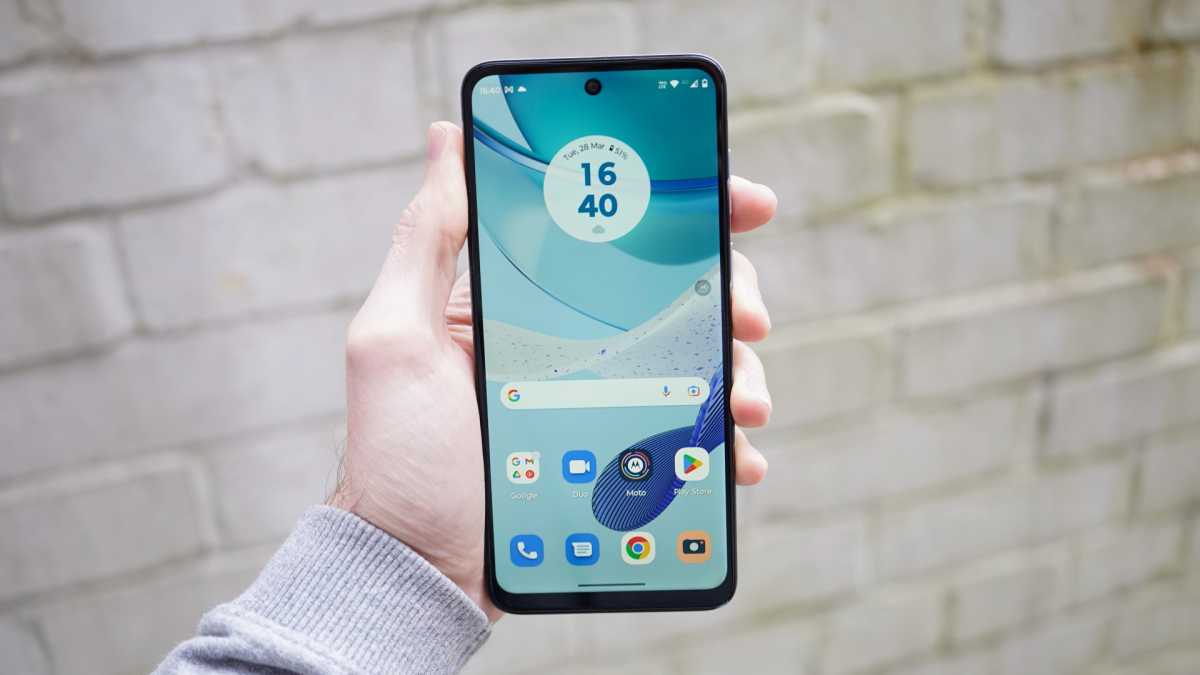
Jon Mundy / Foundry
This stylish, highly functional app also offers tips on how to get the best out of the phone, as well as personalisation options and access to useful features like Attentive display (which doesn’t power the screen down when you’re looking at it).
Notable by their absence are the cluster of useless preinstalled apps that blight many an affordable (and not so affordable) rival. This lack of bloatware really shouldn’t be as noteworthy as it is, but them’s the breaks.
It’s a shame the Moto G53’s hardware weighs the whole software experience down somewhat, as it’s not as silky smooth as it could be. Still, Motorola’s custom UI remains a classy customer.
Price & Availability
The Moto G53 has arrived with an RRP of £189.99. That price is available on Motorola’s own shop while Amazon typically sells it for less.
You can also buy it from Currys, John Lewis and Very. The G53 doesn’t have an official launch in the US so look to the Moto G Power 5G as a very similar alternative.
That price puts the Moto G53 into competition with the likes of the Poco M5, with its £179 price. The Poco supplies a couple of extras, including a Full HD display and a slightly speedier CPU. Conversely, Motorola’s classy software is way preferable to Xiaomi’s.
Check out more options in our best budget phones and best cheap 5G phones charts.
Verdict
The Moto G53 is another perfectly functional phone from Motorola, but its hardware doesn’t feel quite as well thought through as previous entries. What use is a 120Hz refresh rate when the hardware isn’t quite up to the task of outputting consistently smoothly? Especially when that display has a sub-optimal 720p resolution and mediocre colour accuracy.
Another slightly superfluous inclusion is 5G connectivity. Sure, it’s a nice thing to have, but at this end of the market, it typically comes at the expense of more useful features, like a Full HD display or a superior processor.
The main 50Mp camera can hold its own in very good lighting, but it suffers in tricky conditions, and there’s no ultrawide option, just a pointless macro lens.
Motorola’s clean Android UI is here to save the day, as always, and will always be a point of distinction over better-specced Xiaomi rivals. But I can’t escape the feeling that Motorola needs to focus its affordable phone efforts a little and hone in on what really matters.
Specs
- Android 13
- 6.5in, HD+, IPS LCD, 120Hz, flat display
- Side-mounted fingerprint sensor
- Qualcomm Snapdragon 480+
- 4GB RAM
- 128GB storage, up to 1TB microSD
- 50Mp, f/1.8 main camera
- 2Mp macro camera
- Up to 1080p @ 30fps rear video
- 8Mp front-facing camera
- Dolby Atmos stereo speakers
- Dual-SIM
- Wi-Fi 802.11 a/b/g/n/ac
- Bluetooth 5.1
- 5000mAh battery
- 10W charging
- 162.7 x 74.7 x 8.2mm
- 183g
- Launch colours: Ink Blue, Arctic Silver, Pale Pink
Related Posts

Technical Analysis: 4 Stocks with signs of death crossovers to keep an eye on

HDFC Bank & 3 other fundamentally strong stocks trading above 200 DMA to keep an eye on

Falling Channel Breakout: Multibagger NBFC Stock Shows Bullish Momentum on Daily Chart

4 Fundamentally strong stocks to buy for an upside potential of up to 36%; Do you hold any?

